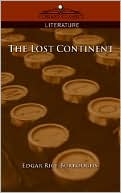

 |

|

The average rating for The Lost Continent based on 2 reviews is 3.5 stars.
Review # 1 was written on 2020-10-15 00:00:00 Patrick Mcadoo Patrick McadooA relatively obscure but enjoyable little book, very similar in both plot and structure to A Princess of Mars - except that instead of finding himself marooned on the Red Planet, our hero here finds himself stranded in 2137 Europe, two hundred years after an endless "Great War" and the severance of all contact between the Americas and Europe/Asia. Western Europe has been reduced to rubble and barbarism - and lions! - although fortunately for our hero, it is somehow still able to produce a very Dejah Thoris-like princess: Written in 1915 when an isolationist America still expected to stay out of the war, Burroughs not only takes on the insanity of "World War," but also takes a neat stab at slavery and racism as well. So if (and probably ONLY if) you enjoy John Carter, you will likely get a kick out of this as well. |
Review # 2 was written on 2012-02-06 00:00:00 Xenia Henrie Xenia HenrieBy 1916, Edgar Rice Burroughs was already a popular and regular contributor to the pulp periodicals of the day. Though a late starter--his first work, the John Carter story "Under the Moons of Mars," was serialized in "All-Story Magazine" in 1912, when Burroughs was 36--his output increased rapidly, to the point that by 1916, he had already seen the first three Carter works, the first two Tarzan titles, the first Pellucidar entry ("At the Earth's Core"), plus such various works as "The Eternal Savage," "The Monster Men" and "The Cave Girl," all printed in that same magazine. But despite his reputation at "All-Story," he still managed to get his manuscript for "Beyond Thirty" rejected there. This short novel was written between July and August 1915, and ultimately appeared in the February 1916 issue of "All-Around Magazine." Though not nearly as highly regarded as some of those other works mentioned above, this slim book is an interesting and exciting one nevertheless. The hippies of the 1960s had an expression that went "Don't trust anyone over 30." Well, in Burroughs' novel, which takes place in the year 2137, the united Pan-American Federation (all the countries in North, Central and South Americas) might as well have a saying that goes "Don't trust anyone beyond 30"; the 30th longitude, that is. It would seem that in 1921, the warring continent of Europe had been barred from all communication with any countries west of that line. From the 30th longitude bisecting the Atlantic all the way west to the 175th (just west of Hawaii), the citizens of the Federation have freedom of movement. But any communication or travel beyond those lines is strictly forbidden; in other words, complete isolation from Europe and its self-destructive ways. But when 21-year-old Lt. Jefferson Turck, commander of the flying submarine Coldwater, finds himself adrift EAST of 30--the result of sabotage, a monster storm and the mutinous actions of one of his officers--he determines to investigate the forbidden European zone, along with three of his men. His explorations of the now-decimated continent, replete with savage beasts and barely civilized inhabitants, and his run-ins with the still-functional armies of Abyssinia and China, make up the bulk of this swift-moving tale. "Beyond Thirty" is fairly relentless in its pace, and Turck's battles with tigers, lions (ironically, before he arrives in lion-infested London--or rather, what's left of it--he tells us that he hopes to be "feted and lionized"!) and savages should appeal to all red-blooded action fans. Burroughs throws a bit of romance into his tale when Turck encounters a savage young woman named Victory, who claims to be the queen of England (if only Elizabeth II were as spunky and appealing!), and his book ultimately does manage to please, short as it is and a bit skimpy in the area of fully fleshed-out characterizations. It certainly did strike this reader as an effective antiwar piece, so I was surprised to read, in Phillip R. Burger's scholarly essay for the Bison Books edition, that Burroughs rather intended his story to be a call for American military preparedness, in the event that our participation in the Great War should come about. (This Bison Books edition, by the way, also includes excellent essays by Burroughs scholars David Brin and Richard A. Lupoff, and is certainly the volume to go with, despite the inexcusable number of typos that it contains.) Burroughs also provides the reader with clues as to his feelings on race relations in the course of the novel...ambivalently, for the most part. It is difficult to tell precisely how he feels about those Abyssinian warriors here. His attitude toward the Chinese, however, seems a lot more lenient than that found in Sax Rohmer's Fu Manchu "yellow peril" novels of that same era. So brief as the novel is (102 pages in this edition), it yet provides food for thought. Though many of Burroughs' books are filled with inconsistencies, I only found one worthy of mention here. Though the year is said to be 2137 on several occasions during the course of his story, at one point, Turck tells us that the isolation zone was set up in 1921, "two hundred and six years ago." Of course, that should read "two hundred and sixteen," but this could merely be still another typo in a book riddled with so many; let's give Edgar Rice the benefit of the doubt here. The bottom line is that "Beyond Thirty" is both a gripping and fascinating tale, and one well worth reading, almost 100 years after its initial release. Needless to say, it is a must-read for all ERB completists.... |
CAN'T FIND WHAT YOU'RE LOOKING FOR? CLICK HERE!!!